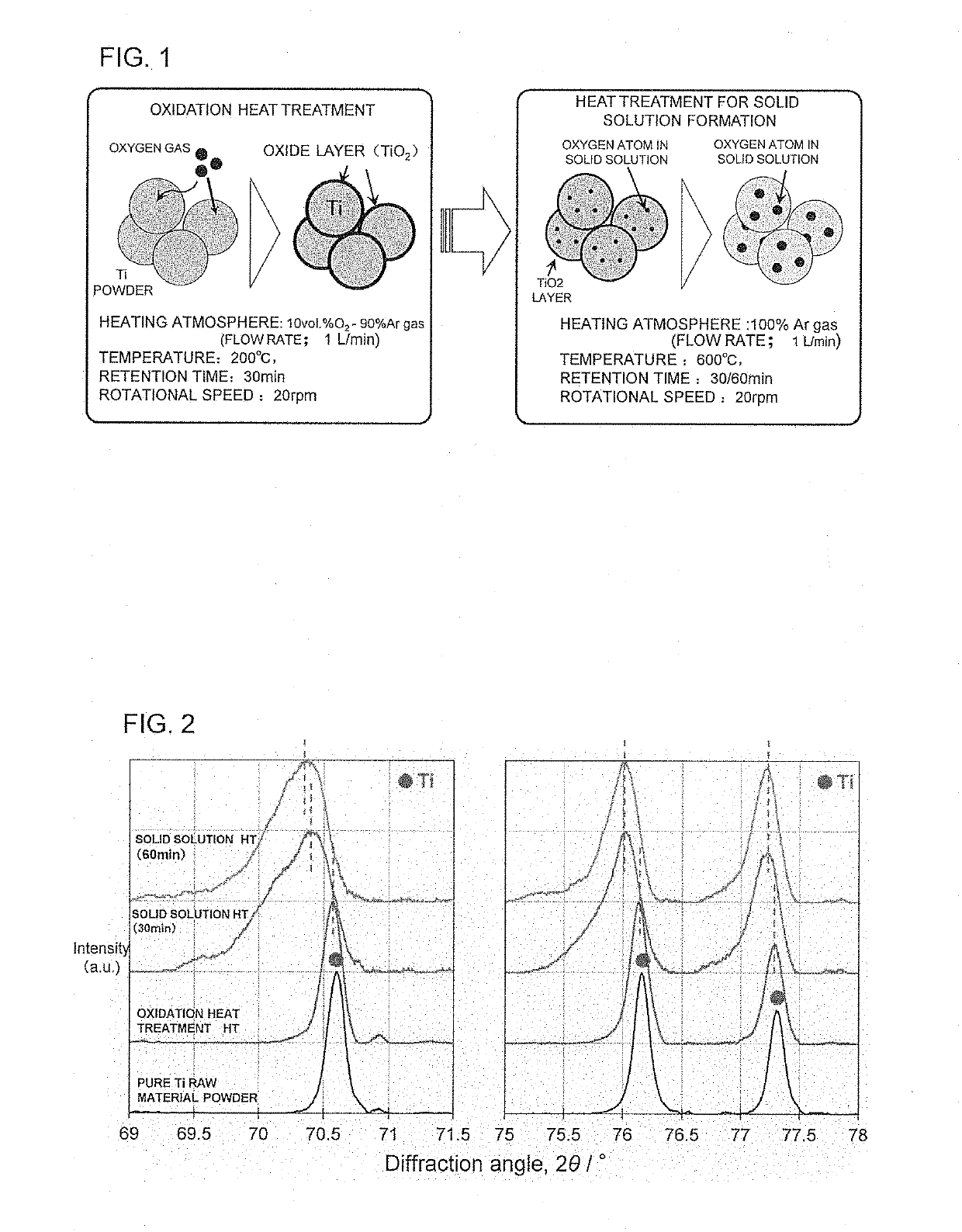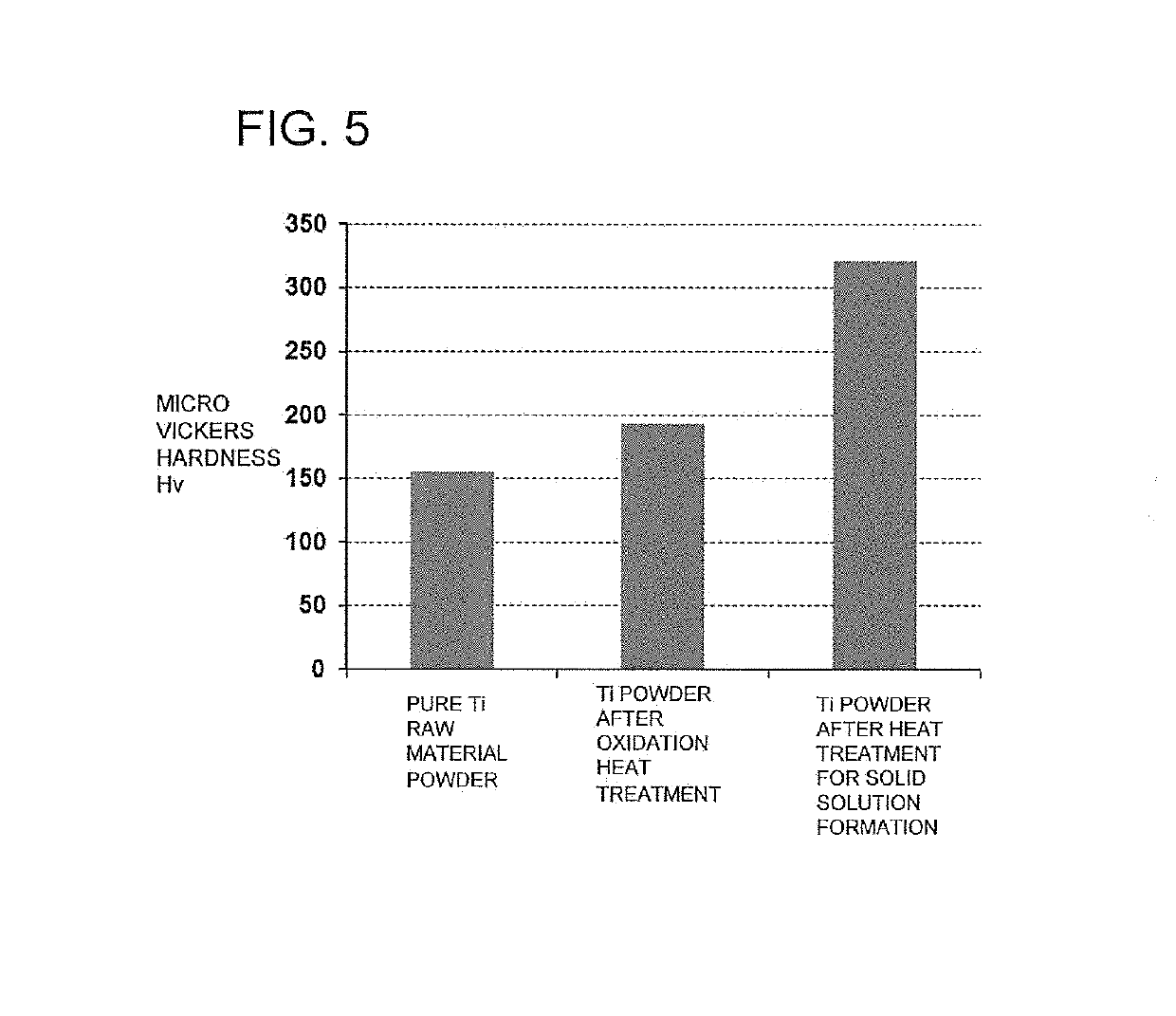Titanium powder, titanium material, and method for producing titanium powder containing solid-soluted oxygen
a technology of titanium powder and solid-solute oxygen, which is applied in the direction of solid-state diffusion coating, transportation and packaging, coatings, etc., can solve the problems of high material cost, limited application of titanium, and high tensile strength of titanium alloys, and achieves higher ductility and strength
- Summary
- Abstract
- Description
- Claims
- Application Information
AI Technical Summary
Benefits of technology
Problems solved by technology
Method used
Image
Examples
example 1
[0084]Pure Ti powder (average grain size: 28 μm, purity: >95%) was used as a starting material. A cycle consisting of the oxidation heat treatment and the heat treatment for solid solution formation shown below was repeated up to four times to produce a solid solution of oxygen in the pure Ti powder.
[0085]Oxidation Heat Treatment
[0086]Atmosphere: mixed gas of 10% O2 and 90% Ar
[0087]Temperature: 200° C.
[0088]Retention time: 15 min
[0089]Rotational speed: 20 rpm
[0090]Heat Treatment for Solid Solution Formation
[0091]Atmosphere: 100% Ar gas
[0092]Temperature: 600° C.
[0093]Retention time: 30 min
[0094]Rotational speed: 20 rpm
[0095]After a die was filled with each Ti powder, a pressure of 600 MPa was applied to produce a columnar powder compact. Thereafter, vacuum sintering (800° C. for 1 hr, degree of vacuum: 6 Pa) was performed to produce a sintered body (diameter φ: 42 mm, total length: 30 mm). The sintered body was preheated in an argon gas atmosphere (1000° C. for 5 min) and then immedi...
example 2
[0103]The influence of the heating temperature of the oxidation heat treatment was examined. Pure Ti powder similar to that used above was used in this example. With oxygen-argon mixed gas (10% O2 and 90% Ar, flow rate: 1 L / min) being introduced into a rotary kiln furnace, 50 g of Ti powder was heated at various heating temperatures in the range of 100 to 700° C. to produce Ti powder. In this oxidation heat treatment, the retention time at each temperature was 1 hour, and the rotational speed was 20 rpm.
[0104]The oxygen content and the appearance (agglomeration, formation of a block) of each Ti powder thus produced were examined. The result is shown in Table 4.
[0105]
TABLE 4RawOxidation Heat Treatment Temperature (° C.)Material100120140160180200220240Oxygen0.210.360.641.021.171.151.161.191.14Content(mass %)AppearancePowderPowderPowderPowderPowderPowderPowderPowderPowderOxidation Heat Treatment Temperature (° C.)300350400450500550600650700Oxygen1.151.191.161.131.211.171.942.322.16Cont...
example 3
[0109]The influence of the heating temperature of the heat treatment for solid solution formation was examined. The oxidation heat treatment was similarly performed on pure Ti powder under the following conditions.
[0110]Heating atmosphere: mixed gas of 10% O2 and 90% Ar (flow rate: 1 L / min)
[0111]Heating temperature: 200° C.
[0112]Retention time: 30 min
[0113]Rotational speed: 20 rpm
[0114]Thereafter, the heat treatment for solid solution formation was performed with a rotary kiln furnace in an argon gas atmosphere at various heating temperatures in the range of 300 to 800° C. to produce Ti powder. In the heat treatment for solid solution formation, the retention time at each temperature was 1 hour, the flow rate of argon gas was 1 L / min, and the rotational speed was 20 rpm.
[0115]In the heat treatment for solid solution formation, two different weights of Ti powder, namely 30 g and 150 g, were placed into the furnace at a time in order to examine the influence of the amount of Ti powder...
PUM
| Property | Measurement | Unit |
|---|---|---|
| temperature | aaaaa | aaaaa |
| temperature | aaaaa | aaaaa |
| melting point | aaaaa | aaaaa |
Abstract
Description
Claims
Application Information
 Login to View More
Login to View More - R&D
- Intellectual Property
- Life Sciences
- Materials
- Tech Scout
- Unparalleled Data Quality
- Higher Quality Content
- 60% Fewer Hallucinations
Browse by: Latest US Patents, China's latest patents, Technical Efficacy Thesaurus, Application Domain, Technology Topic, Popular Technical Reports.
© 2025 PatSnap. All rights reserved.Legal|Privacy policy|Modern Slavery Act Transparency Statement|Sitemap|About US| Contact US: help@patsnap.com



